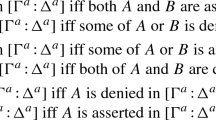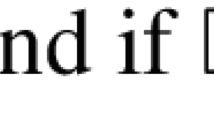Abstract
Is there a principled difference between entailments in natural language that are valid solely in virtue of their form or structure and those that are not? This paper advances an affirmative answer to this question, one that takes as its starting point Gareth Evans’s suggestion that semantic theory aims to carve reality at the joints by uncovering the semantic natural kinds of the language. I sketch an Evans-inspired account of semantic kinds and show how it supports a principled account of structural entailment. I illustrate the account by application to a case study involving the entailment properties of adverbs; this involves developing a novel proposal about the semantics for adverbs like ‘quickly’ and ‘slowly’. In the course of the discussion I explore some implications of the account for the place of model-theoretic tools in natural language semantics.
Similar content being viewed by others
References
Balcerak Jackson, B. (2006). Logical form: Classical conception and recent challenges. Philosophy Compass, 1, 303–316.
Balcerak Jackson, B. (2007). Beyond logical form. Philosophical Studies, 132, 347–380.
Balcerak Jackson, B. (2009). Understanding and semantic structure: Reply to Timothy Williamson. Proceedings of the Aristotelian Society, 109, 337–343.
Balcerak Jackson B, Penka D (forthcoming) Number word constructions, degree semantics, and the metaphysics of degrees. Linguistics and Philosophy.
Barwise, J., & Cooper, R. (1981). Generalized quantifiers and natural language. Linguistics and Philosophy, 4, 159–219.
Bealer, G. (1982). Quality and concept. Oxford: Clarendon Press.
Bellert, I. (1977). On semantic and distributional properties of sentential adverbs. Linguistic Inquiry, 8, 337–351.
Boyd, R. (1989). What realism implies and what it does not. Dialectica, 43, 5–29.
Boyd, R. (1999). Homeostasis, species, and higher taxa. In R. A. Wilson (Ed.), Species: New interdisciplinary essays (pp. 141–185). Cambridge: MIT Press.
Burnett, H. (2012). The puzzle(s) of absolute adjectives: On vagueness, comparison, and the origin of scale structure. UCLA Working Papers in Linguistics, 19, 1–50.
Burnett, H. (2014). A delineation solution to the puzzles of absolute adjectives. Linguistics and Philosophy, 37, 1–39.
Chalmers, D. J. (2002). On sense and intension. Philosophical Perspectives, 16, 135–182.
Champollion, L. (2015). The interaction of compositional semantics and event semantics. Linguistics and Philosophy, 38, 31–66.
Cinque, G. (1999). Adverbs and functional heads: A cross-linguistic perspective. New York, NY: Oxford University Press.
Cresswell, M. J. (1974). Adverbs and events. Synthese, 28, 455–481.
Cresswell, M. J. (1976). The semantics of degree. In B. Partee (Ed.), Montague grammar. New York, NY: Academic Press.
Davidson, D. (1966). Theories of meaning and learnable languages. In Y. Bar-Hillel (Ed.), Proceedings of the 1964 international congress for logic, methodology and philosophy of science (pp. 3–17). Amsterdam: North Holland.
Davidson, D. (1967a). Truth and meaning. Synthese, 17, 304–323.
Davidson, D. (1967b). The logical form of action sentences. In N. Rescher (Ed.), The logic of decision and action (pp. 81–95). Pittsburgh: University of Pittsburgh Press.
Davidson, D. (1970). Semantics for natural languages. In C. Olivetti (Ed.), Linguaggi nella Societa e nella Tecnica. Milan: Edizioni di Comunità.
Davidson, D. (1973). In defence of convention T. In H. Leblanc (Ed.), Truth, syntax and modality (pp. 76–86). Dordrecht: North-Holland.
Dowty, D. (2003). The dual analysis of adjuncts and complements in categorial grammar. In Lang, M., & Fabricius-Hansen, C. (eds.), Modifying adjuncts (pp. 33–66). Berlin: de Gruyter.
Eckardt, R. (1998). Adverbs, events, and other things: Issues in the semantics of manner adverbs. Tübingen: Max Niemeyer Verlag.
Evans, G. (1985). Semantic structure and logical form. In A. Phillips (Ed.), Collected papers (pp. 49–75). Oxford: Oxford University Press.
Higginbotham, J. (1985). On semantics. Linguistic Inquiry, 16, 547–593.
Horwich, P. (2001). Deflating compositionality. Ratio, 14, 369–385.
Jackendoff, R. S. (1990). Semantic structures. Cambridge: MIT Press.
Jacobson, P. (2014). Compositional semantics: An introduction to the syntax/semantics interface. Oxford: Oxford University Press.
Johnson, K. (2003). Are there semantic natural kinds of words? Mind and Language, 18, 175–193.
Katz, G. (2003). Event arguments, adverb selection, and the Stative Adverb Gap. In E. Lang, C. Maienborn, & C. Fabricius-Hansen (Eds.), Modifying adjuncts (pp. 455–474). Berlin: Mouton de Gruyter.
Kempson, R. (2011). Formal semantics and representationalism. In C. Maienborn, K. von Heusinger, & P. Portner (Eds.), Semantics: An international handbook of natural language meaning (pp. 216–241). Berlin: Mouton de Gruyter.
Kennedy, C. (1999). Projecting the adjective: The syntax and semantics of gradability and comparison. New York, NY: Garland Publishing.
Kennedy, C., & McNally, L. (2005). Scale structure, degree modification, and the semantics of gradable predicates. Language, 81, 345–381.
King, J. C. (2007). The nature and structure of content. Oxford: Oxford University Press.
Klein, E. (1980). A semantics for positive and comparative adjectives. Linguistics and Philosophy, 4, 1–45.
Kratzer, A. (1996). Severing the external argument from its verb. In J. Rooryck & L. Zaring (Eds.), Phrase structure and the Lexicon (pp. 109–138). Dordrecht: Kluwer.
Lepore, E., & Ludwig, K. (2002). What is logical form? In G. Preyer & G. Peter (Eds.), Logical form and language. Oxford: Oxford University Press.
Levin, B. (1993). English verb classes and alternations. Chicago, IL: The University of Chicago Press.
Lewis, D. (1975). Languages and language. In K. Gunderson (Ed.), Minnesota studies in the philosophy of science (pp. 3–35). Minneapolis: University of Minnesota Press.
Lidz, J., Pietroski, P., Hunter, T., & Halberda, J. (2011). Interface transparency and the psychosemantics of ‘most’. Natural Language Semantics, 19, 227–256.
Ludlow, P. (2002). LF and natural logic. In G. Preyer & G. Peter (Eds.), Logical form and language (pp. 132–168). Oxford: Oxford University Press.
Maienborn, C., & Schäfer, M. (2011). Adverbs and adverbials. In K. von Heusinger, C. Maienborn, & P. Portner (Eds.), Semantics: An international handbook of natural language meaning (Vol. II, pp. 1390–1419). Berlin: De Gruyter Mouton.
McConnell-Ginet, S. (1982). Adverbs and logical form: A linguistically realistic theory. Language, 58, 144–184.
McGilvray, J. (1998). Meanings are syntactically individuated and found in the head. Mind and Language, 13, 225–280.
Montague, R. (1974a). English as a formal language. In Formal philosophy: Selected papers of Richard Montague. New Haven: Yale University Press.
Montague, R. (1974b). Universal grammar. In Formal philosophy: Selected papers of Richard Montague. New Haven: Yale University Press.
Montague, R. (1974c). The proper treatment of quantification in ordinary English. In Formal philosophy: Selected papers of Richard Montague. New Haven: Yale University Press.
Parsons, T. (1990). Events in the semantics of english: A study in subatomic semantics. Cambridge: MIT Press.
Pietroski, P. (2003a). The character of natural language semantics. In A. Barber (Ed.), The epistemology of language (pp. 217–256). Oxford: Oxford University Press.
Pietroski, P. (2003b). Small verbs, complex events: Analyticity without synonymy. In L. M. Antony (Ed.), Chomsky and his critics. Malden: Blackwell.
Pietroski, P. (2005a). Events and semantic architecture. New York, NY: Oxford University Press.
Pietroski, P. (2005b). Meaning before truth. In G. Preyer & G. Peter (Eds.), Contextualism in philosophy (pp. 253–300). Oxford: Oxford University Press.
Pietroski, P. (Forthcoming). Conjoining meanings: Semantics without truth values. Oxford: Oxford University Press.
Pietroski, P., Lidz, J., Halberda, J., & Hunter, T. (2009). The meaning of ‘most’: semantics, numerosity, and psychology. Mind and Language, 24, 554–585.
Quine, W. V. (1951). Two dogmas of empiricism. Philosophical Review, 60, 20–43.
Salmon, N. (1986). Frege’s puzzle. Cambridge: MIT Press.
Soames, S. (1987). Direct reference, propositional attitudes and semantic content. Philosophical Topics, 15, 47–87.
Szabó, Z. G. (2015). Major parts of speech. Erkenntnis, 80, 3–29.
Szabó, Z. G. (in preparation). Semantic explanations.
Thomason, R., & Stalnaker, R. (1973). A semantic theory of adverbs. Linguistic Inquiry, 4, 195–220.
van Rooij, R. (2011). Implicit vs. explicit comparatives. In P. ÉgrÉ & N. Klinedinst (Eds.), Vagueness and language use (pp. 51–72). London: Palgrave Macmillan.
von Stechow, A. (1984). Comparing semantic theories of comparison. Journal of Semantics, 3, 1–77.
Wheeler, S. (1972). Attributives and their modifiers. Noûs, 6, 310–334.
Williams, E. (1983). Semantic vs. syntactic categories. Linguistics and Philosophy, 6, 423–446.
Williamson, T. (2003). Blind reasoning. Proceedings of the Aristotelian Society, 77, 249–293.
Williamson, T. (2008). The philosophy of philosophy. Oxford: Blackwell.
Wright, C. (1981). Rule-following, objectivity and the theory of meaning. In S. H. Holtzman & C. M. Leich (Eds.), Wittgenstein: To follow a rule (pp. 99–117). Oxford: Routledge.
Zimmermann, T. E. (1999). Meaning postulates and the model-theoretic approach to natural language semantics. Linguistics and Philosophy, 22, 529–561.
Author information
Authors and Affiliations
Corresponding author
Rights and permissions
About this article
Cite this article
Balcerak Jackson, B. Structural entailment and semantic natural kinds. Linguist and Philos 40, 207–237 (2017). https://doi.org/10.1007/s10988-017-9204-0
Published:
Issue Date:
DOI: https://doi.org/10.1007/s10988-017-9204-0




